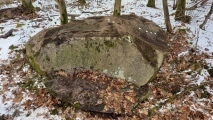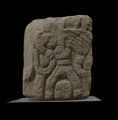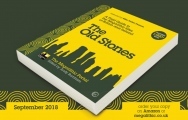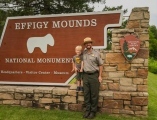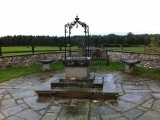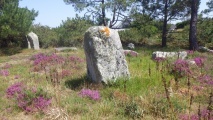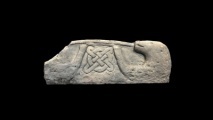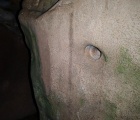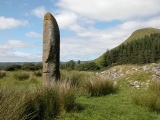Andy Burnham's Blog, page 34
February 18, 2025
Schälchenstein Stegelitz 1
One of the two newly discovered cup marked stones in the Forst Suckow in Brandenburg. A stone with at least 9 cup marks. 5 at the highest point and 4 on the side sloping to the east. The cups are flat but clearly recognizable.
A part of the stone has been broken off by stone cutters. The piece that was not broken off perfectly is still lying next to it.
A part of the stone has been broken off by stone cutters. The piece that was not broken off perfectly is still lying next to it.
Published on February 18, 2025 03:37
February 17, 2025
St Hilda's Church (Sherburn)
The only surviving stone in England showing the face of Wayland the Smith. He is strapped into his flying device with his hands grasping on to a female figure who has her waist wedged into the beak of a headpiece that the Flying Smith is wearing. 3D model by Roger Lang, University of Durham. The history of the Church of St Hilda stretches back to Norman times, as shown by the tower and nave, plus there are some fragments of Saxon sculpture and medieval glass. It was extensively restored in the last century and the completion of the work was celebrated by the erection of a memorial cross in the village.
Published on February 17, 2025 15:50
Andy B's Old Stones Talk at Canterbury Waterstones, 12th March
Andy returns to Canterbury Waterstones for the third time on the 12th March this year to present his talk, which covers many of the fascinating themes, mysteries and new discoveries highlighted in our book, The Old Stones, a past winner of Current Archaeology Book of the Year.
Published on February 17, 2025 05:36
February 16, 2025
Effigy Mounds National Monument
US Forest Service and National Park Service are firing thousands of workers including Ranger Brian here - chaos is predicted. Artificial Mounds in Iowa dating to 1000 AD and earlier, on headlands above the Mississippi River. Over 200 earthen mounds are preserved within the park, 31 of the mounds are in the form of animals like bears or birds.
Published on February 16, 2025 12:48
St Meilig’s Well
Originally thought to be a pagan site, this holy well near Hay-on-Wye was later dedicated to St Meilig, a 6th century monk. The broken capstone bears the inscription “Proverbs XII 1903 JC”.
Published on February 16, 2025 05:12
Jacobs Well
Jacobs Well is thought to pre-date the nearby town of Guildford, as it is mentioned in historical memoirs from a time when the town was little more than a hamlet. People then believed the well to pre-date even those few buildings. The well soon came under the ownership of a local farm. Later, the field containing the well was gifted to the Catholic church, and the well fell under their jurisdiction.
Published on February 16, 2025 05:05
February 15, 2025
Menhirs de Narbon
400m west of Narbon are a series of blocks, two of which are standing up to 1.8 metres and a dozen or so fallen.
Published on February 15, 2025 06:58
February 14, 2025
Durham Cathedral Museum
Roger Lang, a Research Student in the Department of Archaeology at Durham has uploaded 3D models of all the Brompton Hogbacks & cross shaft fragments, around half of which are in Durham Cathedral Museum, more details in the comments on our page. Durham Cathedral Museum is spread out over three rooms, each with unique displays from the cathedral’s historic collections. Today, inside the church are pre-Norman items, including three of the early 10th century hogback tombstones with flanking sitting bears, and two crosses.
Published on February 14, 2025 07:39
West Kennett Long Barrow
Top photo: the polisher stone inside the barrow - can you see the owl figure that I do asks Bladup?. More than 100m long and 2.4m high, this is one of Britain's biggest chambered long barrows, and the 10m long interior chambers are open for viewing. Excavations in 1859 and 1955-56 found 46 burials of all ages. The tomb may have been in use for 1000 years - incredible.
Published on February 14, 2025 07:39
February 12, 2025
An Introduction to the Archaeoastronomy and Standing Stones Web Site
David Hoyle has written an introduction to how his landscape and horizon viewer web site app that links from our site pages works: Archaeoastronomy is the study of how ancient people understood and used the sky, and the role it played in their cultures. The location of a site within its landscape, along with relevant markers, is crucial in this study. It suggests that a cosmological system was maintained from the late Neolithic to the Late Bronze Age, and many Bronze Age monuments, especially those from the latter part of the Bronze Age, have been shown to follow specific astronomical patterns.
Published on February 12, 2025 10:00

